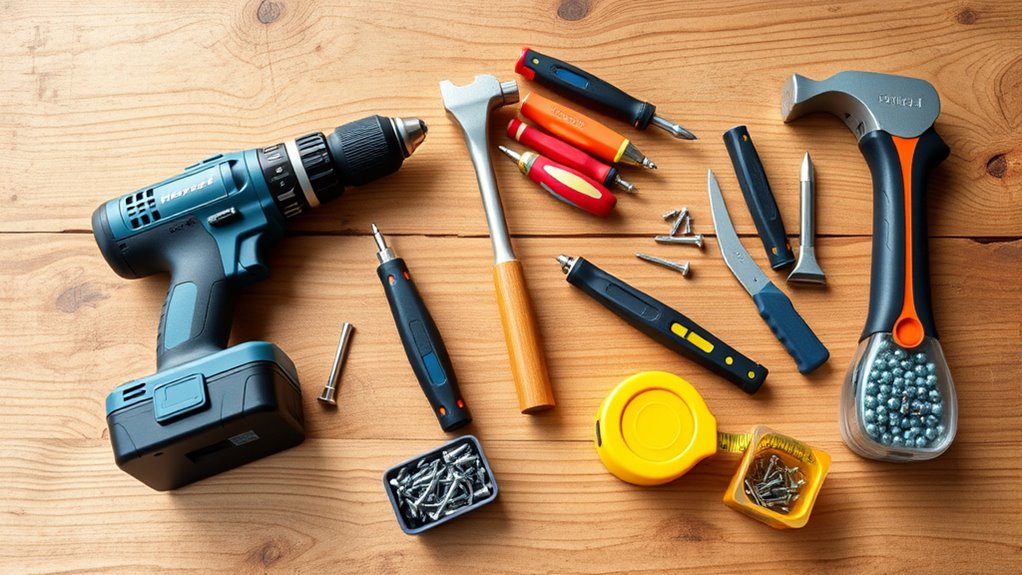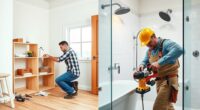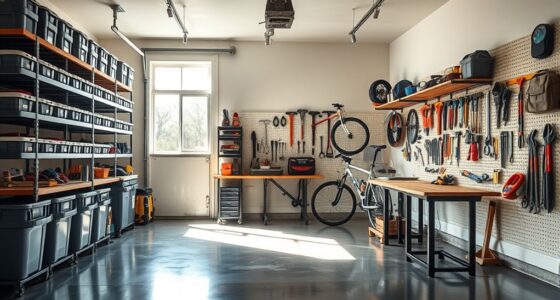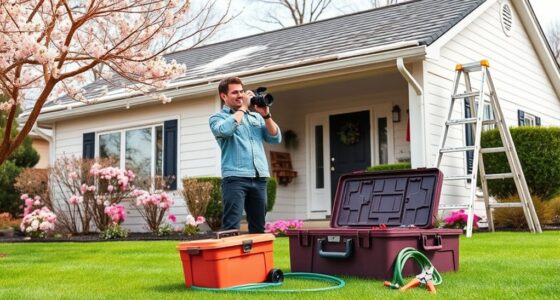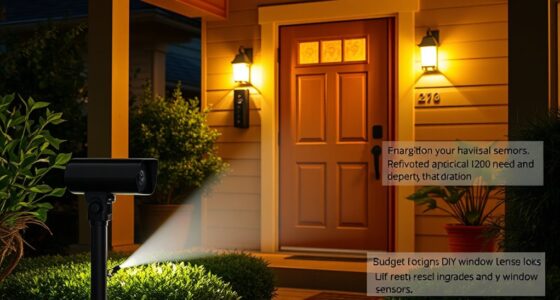As a new homeowner, building your DIY toolkit is key to handling everyday repairs and improvements with confidence. Start with basic hand tools like a hammer, screwdrivers, pliers, and an adjustable wrench for most tasks. Add power tools such as a cordless drill and saw for bigger jobs. Don’t forget safety gear, fasteners, and household essentials like a level and measuring tape. Keep your toolkit organized to streamline projects, and you’ll find more helpful items that make home upkeep easier.
Key Takeaways
- Start with basic hand tools like a hammer, screwdrivers, pliers, and an adjustable wrench for versatile home repairs.
- Include power tools such as a cordless drill and saw for efficient furniture assembly and larger projects.
- Ensure safety equipment like safety glasses, a work light, and a first aid kit are part of your toolkit.
- Stock essential fasteners and fixings including nails, screws, wall anchors, and adhesive for secure mounting and repairs.
- Add household and outdoor tools like measuring devices, gardening tools, and organization supplies for all-around home maintenance.
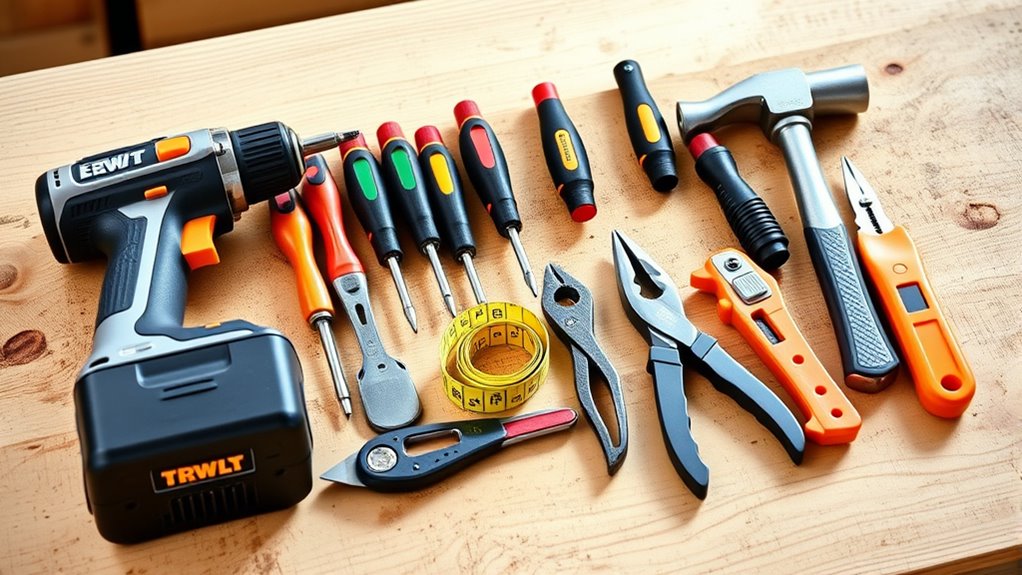
Starting your journey as a new homeowner can be exciting, but having the right tools makes all the difference. When you’re ready to tackle repairs, hang pictures, or perform routine maintenance, a well-stocked toolkit helps you handle most tasks efficiently. You’ll want to invest in some basic hand tools first. A hammer is indispensable for hanging artwork or securing small fixtures. A screwdriver set with both flat-head and Phillips-head drivers will become your go-to for assembling furniture, replacing hardware, or fixing appliances. Pliers, including needle-nose and slip-joint types, are versatile for gripping, bending, or twisting objects, making them essential for many repair jobs. An adjustable wrench allows you to tighten or loosen bolts and nuts of various sizes, giving you flexibility during assembly or repairs. A utility knife is another must-have for cutting through cardboard, drywall, or packaging materials. These basic hand tools form the foundation of your DIY toolkit.
Start your DIY journey with essential hand tools like a hammer, screwdriver set, pliers, wrench, and utility knife.
Once you’ve got your hand tools, it’s smart to add power tools that make tasks quicker and easier. A cordless drill is incredibly versatile — perfect for drilling holes and driving screws into wood, drywall, or metal. A power saw, such as a circular or miter saw, helps you cut lumber with precision, especially when working on larger projects like furniture or shelving. A rotary tool offers detailed cutting, grinding, or polishing, which is useful for more delicate work. For curved cuts or intricate designs, a jigsaw is highly effective. An impact driver provides high torque, making it ideal for tougher tasks like installing deck boards or tackling stubborn screws. These power tools save time and effort, helping you complete projects more efficiently.
Safety should never be overlooked, so equip yourself with safety glasses to protect your eyes from debris. A work light ensures good visibility in dim areas or during nighttime projects. Keep a first aid kit nearby for treating minor injuries, and a flashlight is essential for working in dark corners or during outages. A fire extinguisher adds a layer of safety, especially when working with electrical or flammable materials.
Fasteners and fixings are also crucial. Keep nails, screws, and wall anchors on hand for securing items or mounting shelves. Duct tape and glue come in handy for temporary fixes or bonding materials. Sanding paper is useful for smoothing rough surfaces before painting or finishing. Maintaining a tidy and functional home requires these essentials.
Finally, household and outdoor tools round out your toolkit. A broom, dustpan, mop, and vacuum keep your space clean. Gardening tools like pruning shears, a rake, and a garden hose support outdoor maintenance. Measuring and leveling tools such as a tape measure, level, and stud finder ensure your projects are accurate and aligned. With these essential tools, you’re well-prepared to handle most homeownership tasks confidently and efficiently.
Frequently Asked Questions
How Do I Choose the Right Power Drill for My Needs?
When choosing the right power drill, consider the tasks you’ll perform most often. If you need to drill into tough materials or drive large fasteners, pick a higher voltage drill with more torque. For light tasks, a lower voltage model works. Think about features like adjustable clutch, ergonomics, and battery life. Also, select a trusted brand with a good warranty to guarantee durability and support for your DIY projects.
What Safety Gear Should I Always Have on Hand?
Think of safety gear as your home’s armor—you need it ready for battle. Always keep safety glasses or goggles to protect your eyes from debris, and a respirator or dust mask to defend your lungs during dusty tasks. Gloves shield your hands, and a hard hat can prevent head injuries. Keep fire extinguishers, first aid kits, and ear protection nearby. This gear guarantees you’re prepared for any DIY challenge.
How Often Should I Replace or Upgrade My Tools?
You should replace or upgrade your tools when you notice signs of wear, performance drops, or safety concerns. Power tools and specialized equipment may need more frequent updates, especially with heavy use. Regular maintenance can extend their lifespan, but don’t hesitate to upgrade to newer, more efficient models with better features. Ultimately, weigh the costs of repairs against buying new tools to make the best decision for your DIY projects.
Are There Eco-Friendly or Sustainable Tools Available?
Yes, eco-friendly and sustainable tools are widely available today. You can find bamboo window squeegees, long handle dustpans, and eco-friendly dish brushes that reduce plastic waste. For outdoor use, consider battery-powered lawn mowers or rain barrels. These tools help you maintain your home while minimizing environmental impact. Incorporating them into your routine supports greener living and makes your home more sustainable over time.
How Can I Organize My Toolkit for Easy Access?
Imagine your toolkit as a well-tended garden, each tool like a flower in perfect view. To keep it accessible, use clear containers and label everything, so you can find what you need at a glance. Hang frequently used tools on a pegboard and group similar items together. Regularly tidy and maintain your setup, turning chaos into harmony—making your DIY projects smoother and more enjoyable.
Conclusion
With the right tools, you gain confidence and independence, turning your house into a home. But remember, each nail you hammer and each repair you tackle remind you of the journey ahead—sometimes messy, often rewarding. Your toolkit isn’t just about fixing things; it’s about creating a space where memories unfold. Embrace the challenges and celebrate the victories—because in building your home, you’re also building your confidence and your story.

